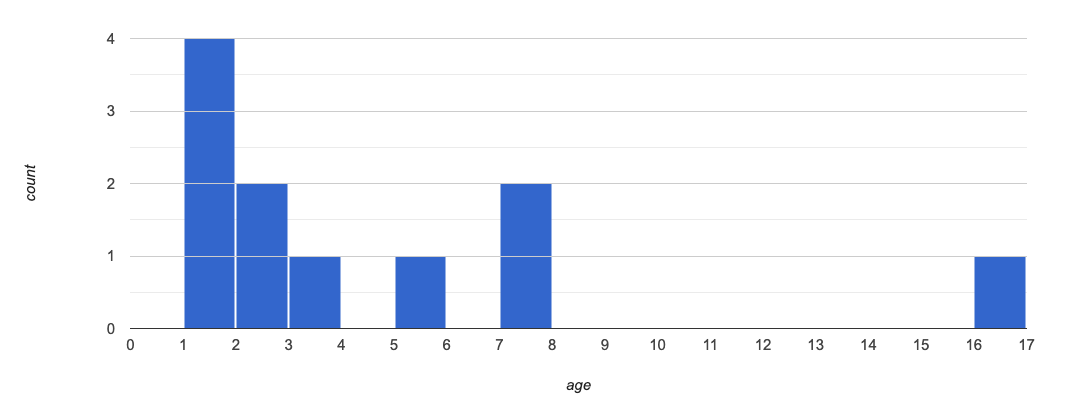The histogram below shows the ages of eleven cats at the shelter:

1 Describe the shape of this histogram.
2 How many cats are 1 year old? 2 years old? Fill in the table below by reading the histogram. The first column has been done for you.
| age | 1 | 2 | 3 | 4 | 5 | 6 | 7 | 8 | 9 | 10 | 11 | 12 | 13 | 14 | 15 | 16 |
|---|---|---|---|---|---|---|---|---|---|---|---|---|---|---|---|---|
count |
4 |
3 What is the mean age of the cats in this histogram?
4 Draw a star to identify the mean on the histogram above.
5 For each cat in the histogram above, draw a horizontal arrow from the mean to the cat’s interval, and label the arrow with its distance from the mean. (For example, if the mean is 2 and a cat is 5 years old, your arrow would stretch from 2 to 5, and be labeled with the distance "3")
To compute the standard deviation we square each distance and take the average, then take the square root of the average.
6 Recorded the 11 ages shown in the histogram in the first row of the table below. For each age, compute the distance from the mean and the squared distance.
age of cat |
|||||||||||
distance from mean |
|||||||||||
squared distance |
7 Add all the squared distances. What is their sum?
8 Divide the sum by N-1. What do you get?
9 Take the square root to find the standard deviation!
10 How did the outlier impact the standard deviation?
These materials were developed partly through support of the National Science Foundation, (awards 1042210, 1535276, 1648684, 1738598, 2031479, and 1501927).  Bootstrap by the Bootstrap Community is licensed under a Creative Commons 4.0 Unported License. This license does not grant permission to run training or professional development. Offering training or professional development with materials substantially derived from Bootstrap must be approved in writing by a Bootstrap Director. Permissions beyond the scope of this license, such as to run training, may be available by contacting contact@BootstrapWorld.org.
Bootstrap by the Bootstrap Community is licensed under a Creative Commons 4.0 Unported License. This license does not grant permission to run training or professional development. Offering training or professional development with materials substantially derived from Bootstrap must be approved in writing by a Bootstrap Director. Permissions beyond the scope of this license, such as to run training, may be available by contacting contact@BootstrapWorld.org.